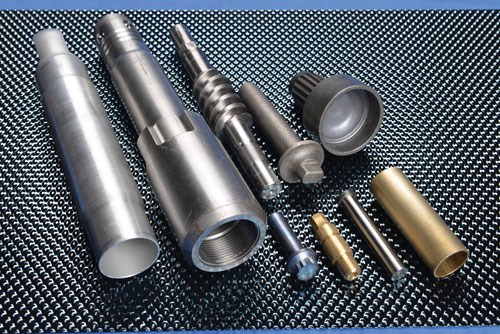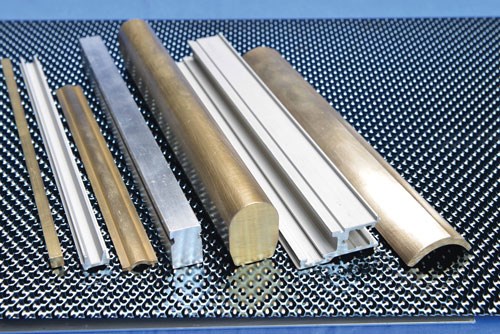Load and Unload Pre-Processed Workpieces
The best application for this loader is in shops that process saw-cut, semi-finished, extrusions, forgings or castings and near-net shape blanks in CNC turning centers and multitasking machines.
Automating workhandling is something that most shops are familiar with. In most turning and multitasking operations, getting the workpiece blanks into and out of the machine tool is automation well applied. Finding operators to load and unload machines is both difficult and expensive.
Among the many ways that machine builders and workhandling accessory makers are answering the automation need, most common is the overhead gantry, bar feeder and parts loader and unloader systems. PM recently sat down with Mike Davis, who is key accounts manager for Lexair to discuss a loader/unloader system his company is distributing in North America.
The loader and unloader are made in Germany by Breuning Irco, and Lexair is the exclusive importer. The company also has an extensive line of bar feeders, with models capable of handling barstock up to 5.1 inches in diameter and 24 feet in length, which can be larger and/or longer based upon application. “With this line,” Mr. Davis says, “we can mix and match equipment to fit the application. A bar feeder can be installed on the headstock end of the machine and a parts unloader on the tailstock or subspindle end if the parts are too long for the machine’s parts catcher.”
However, the best application for this loader is in shops that process saw-cut, semi-finished, extrusions, forgings or castings and near-net shape blanks in its CNC turning centers and multitasking machines. When tied to its mirror image parts unloader, continuous processing is possible. With lights-out production increasingly being employed, the ability to have seamless throughput is paramount.
A key technological advantage in the model RBL loader, Mr. Davis says, is the use of servo-driven technology that allows for programmable orientation and feeding of symmetrical and non-symmetrical workpiece blanks without the need for a mechanical stop. It not only saves a valuable tool station on the turning center, it eliminates feeding errors from bounce-back. The model REX unloader also uses fully programmable servomotor technology. It can also handle no-mar specifications for parts that require such surface finishes.
Many shops, especially those working in medium- to high-volume production, are machining workpiece blanks that are pre-processed. Moreover, many of the parts require backworking on a subspindle equipped machine, hence the need to unload the subspindle and secure a complete part.
Typical applications for these load/unload accessories are in applications with an emphasis on shaft-type workpiece blanks. “We see these going into companies that are manufacturing cylinder rods, motor shafts and other OEM applications,” Mr. Davis says.
In operation, the workpiece is taken from an integral magazine tray and placed in a guiding prism made of synthetic material. A material pusher feeds the workpiece a programmed distance through a matching spindle liner tube in the spindle bore.
For non-symmetrical parts, the loader uses a shaped guiding prism to orient the blank into a geometrically matching spindle liner. Also for non-symmetrical parts (those that will not roll), a conveyor can be used on the magazine to feed parts into the guide prism for orientation. On multitasking machines, much of the frontworking and backworking metalcutting operations involve milling, so the ability to properly orient the part is critical. The unloader likewise uses an integral tray or conveyor on the discharge end of the machine. While over-the-part collets can be configured for the unload side of the machine, gripping on an ID is preferred to reduce collet stroke.
Also on the unload side of the turning center, the subspindle moves in the Z axis—essentially a sliding headstock. The model REX interfaces with the subspindle using a telescoping connection that can follow the Z-axis movements. The connection uses precision sized bushings that act like a spindle liner.
For field installation of the loader on a turning center, a magazine interface with the CNC is required. This interface is normally available. If the unloader is used as well, a second magazine interface is needed from the machine’s CNC. Mr. Davis notes that for the unloader, a rear exit or low exit chip conveyor is necessary.
Breuning Irco material handling equipment is MT Connect capable. According to Mr. Davis, there are two levels of interface available, depending on the application. With the standard interface, the loader is essentially a slave to the machine and operates on commands from the CNC program. “We find that for the model RBL and REX, this interface is usually sufficient because the higher volume production applications for pre-processed blanks don’t require data analysis. The units are essentially dedicated automation.”
However, there is an extended interface that can be applied if communication and data analysis are needed. “We use the extended interface on bar feeders primarily for end of bar calculations and parts counting,” Mr. Davis says. “It can be interfaced with the shop’s production control department.”
For easy change-over, such as spindle liners, the loader and unloader can be moved perpendicular or axially to the center line for easy access. Changing liners can be a pain, but this system of putting the loader and unloader on tracks greatly simplifies the task. It can be moved with two fingers, Mr. Davis says.
Selecting the right material handling equipment, whether it is a bar feeder or part loader/unloader can make a huge difference in production efficiency and shop profitability.
Related Content
Automation Idea for Halloween?
Maybe not. But, the candy-throwing robots at MetalQuest’s Nebraska facility do enable the contract machine shop to stand out at career fairs and similar events.
Read MoreStarting Small with Automation
Quick-change workholding and flexible robotic automation started this small shop on the path to success.
Read MoreSwiss-Type Add-On System Enables In-Line Inspection
When small part inspection and/or segregation is critical, this flexible, automated unloading and palletizing system for Swiss-type lathes can be the answer.
Read MoreTips for Troubleshooting and Repairing Chip Conveyors
A nonfunctioning chip conveyor can cause a high-production machine to be down for an extended period of time. Here is some troubleshooting advice if you’re having issues with your chip conveyors.
Read MoreRead Next
Do You Have Single Points of Failure?
Plans need to be in place before a catastrophic event occurs.
Read MoreA Tooling Workshop Worth a Visit
Marubeni Citizen-Cincom’s tooling and accessory workshop offers a chance to learn more about ancillary devices that can boost machining efficiency and capability.
Read MoreSeeing Automated Workpiece Measurement in Real Time
User-friendly inspection software for CNC machining centers was shown at IMTS 2024 monitoring measurements between and after machining while performing SPC based on recorded measurement values.
Read More

























